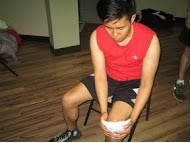
A sprain refers to any injury that affects the ligament, which occurs as a result of abnormal or excessive forces being applied around a joint. The knee, wrist and ankles are the body parts that are highly affected by this problem. Some of the symptoms of sprain include:
- Swelling
- Bruising
- Joint instability
- Tenderness and
- Loss of functions
Sprains are graded according to the extent of the injury. There is:
- Grade one that involves a little bit of stretching of the ligament without joint instability.
- Grade two involving partial rupture of the ligament with no joint instability and
- Grade three that involve full rupture of the ligament accompanied by joint instability.
Principle of paying the PRICE and avoiding HARM on sprain
When giving first aid for sprain, you are encouraged to apply the ‘paying the PRICE’ and ‘avoiding HARM’ for the first two to three days after the occurrence of the injury.
What the Principle “PRICE” Entails
The principle of paying the PRICE involves:
- Protection. This is where you should ensure that the victim of the injury is fully protected from incurring more injuries in the process.
- Rest. For the first two to three days after the sprain, the victim should not engage in any activity. In case of lower limb injuries the victim should be encouraged to use crutches.
- Ice. It is advisable to use an ice pack wrapped in a cloth and apply it for fifteen to twenty minutes after every three hours for the first three days of the injury.
- Compression. This is an important process, which reduces the swelling of the affected area. You can put an elastic bandage around the affected limb and ensure you remove it during the night. However, make sure you do not tie the badge tightly to allow easy circulation.
- Elevation. The injured area needs to be elevated above the heart level for the first two to three days and ensure that is supported in a comfortable manner.
The Principle of HARM
This principle entails ensuring that the victim is not harmed for the first three days after the sprain has occurred.
- Heat. Do not apply hot baths, saunas and heat packs on the affected area.
- Alcohol. Avoid alcohol as this may increase bleeding and swelling.
- Running. Do not allow the victim to run or carry out any form of exercises.
- Massage. Do not massage the areas to avoid bleeding or swelling.
To learn more about providing care and recognizing sprains and strains enrol in first aid and CPR courses with credible workplace approved providers in Canada and the U.S.A. Ensure that you read our disclaimer page prior to providing any aid.